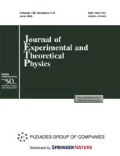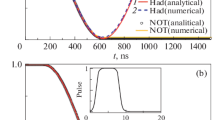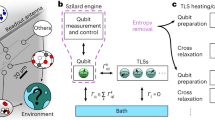Abstract
The conventional technique for controlling the states of individual qubits and quantum registers is based on the use of high-frequency modulated pulses whose carrier frequency is close to the transition frequency between the ground states of “artificial atoms” and “molecules” (the Rabi technique). In this paper, an alternative concept for controlling superconducting qubits is developed that is based on the idea of fast excitation of a quantum system by solitary unmodulated pulses. The formation of entangled Bell states in a two-qubit superconducting register under the action of field pulses obtained by rapid single flux quantum (RSFQ) devices is demonstrated by numerical simulation. The tomography of quantum states is performed by solving the density matrix equation. It is shown that the technique of “unipolar pulses” allows one to speed up the formation of entangled states (at picosecond times) with a fidelity of 95–98%. The execution of the basic quantum algorithms is demonstrated: the Deutsch–Jozsa algorithm with an accuracy of more than 98% and Grover’s algorithm with an accuracy of 93%.






Similar content being viewed by others
REFERENCES
F. Arute, K. Arya, R. Babbush, D. Bacon, J. C. Bardin, R. Barends, R. Biswas, S. Boixo, F. G. S. L. Brandao, D. A. Buell, B. Burkett, Yu Chen, Z. Chen, B. Chiaro, R. Collins, et al., Nature (London, U.K.) 574, 505 (2019).
J. Preskil, Quantum 2, 79 (2018).
A. A. Zhukov, S. V. Remizov, W. V. Pogosov, and Yu. E. Lozovik, Quantum. Inform. Proces. 17, 223 (2018).
A. A. Zhukov, E. O. Kiktenko, A. A. Elistratov, W. V. Pogosov, and Yu. E. Lozovik, Quantum. Inform. Proces. 18, 31 (2019).
Y. Nakamura, Y. A. Pashkin, and J. S. Tsai, Phys. Rev. Lett. 87, 246601 (2001).
G. Wendin, Rep. Prog. Phys. 80, 106001 (2017).
R. Barends, J. Kelly, A. Megrant, A. Veitia, D. Sank, E. Jeffrey, T. C. White, J. Mutus, A. G. Fowler, B. Campbell, Y. Chen, Z. Chen, B. Chiaro, A. Dunsworth, C. Neill, et al., Nature (London, U.K.) 508, 500 (2014).
J. M. Chow, J. M. Gambetta, L. Tornberg, J. Koch, L. S. Bishop, A. A. Houck, B. R. Johnson, L. Frunzio, S. M. Girvin, and R. J. Schoelkopf, Phys. Rev. Lett. 102, 090502 (2009).
Y. He, S. K. Gorman, D. Keith, L. Kranz, J. G. Keizer, and M. Y. Simmons, Nature (London, U.K.) 571, 371 (2019).
L. DiCarlo, J. M. Chow, J. M. Gambetta, L. S. Bishop, B. R. Johnson, D. I. Schuster, J. Majer, A. Blais, L. Frunzio, S. M. Girvin, and R. J. Schoelkopf, Nature (London, U.K.) 460, 240 (2009).
D. V. Averin, K. Rabenstein, and V. K. Semenov, Phys. Rev. B 73, 094504 (2006).
A. Fedorov, A. Shnirman, G. Schoen, and A. Kidiyarova-Shevchenko, Phys. Rev. B 75, 224504 (2007).
A. Herr, A. Fedorov, A. Shnirman, E. Ilichev, and G. Schon, Supercond. Sci. Technol. 20, S450 (2007).
K. K. Likharev and V. K. Semenov, IEEE Trans. Appl. Supercond. 1, 3 (1991).
R. McDermott and M. G. Vavilov, Phys. Rev. Appl. 2, 014007 (2014).
E. Leonard, M. A. Beck, J. Nelson, B. G. Christensen, T. Thorbeck, C. Howington, A. Opremcak, I. V. Pechenezhskiy, K. Dodge, N. P. Dupuis, M. D. Hutchings, J. Ku, F. Schlenker, J. Suttle, C. Wilen, et al., Phys. Rev. Appl. 11, 014009 (2019).
K. Li, R. McDermott, and M. G. Vavilov, Phys. Rev. Appl. 12, 014044 (2019).
M. A. Nielsen and I. L. Chuang, Quantum Computation and Quantum Information (Cambridge Univ. Press, Cambridge, 2000).
N. V. Klenov, A. V. Kuznetsov, I. I. Soloviev, S. V. Bakurskiy, M. V. Denisenko, and A. M. Satanin, Low Temp. Phys. 43, 789 (2017).
M. V. Denisenko, N. V. Klenov, and A. M. Satanin, AIP Conf. Proc. 1936, 020009 (2018).
M. V. Bastrakova, N. V. Klenov, and A. M. Satanin, Phys. Solid State 61, 1515 (2019).
M. V. Denisenko, N. V. Klenov, and A. M. Satanin, J. Exp. Theor. Phys. 128, 227 (2019).
N. V. Klenov, A. V. Kuznetsov, I. I. Soloviev, S. V. Bakurski, and O. V. Tikhonova, Beilstein J. Nanotechnol. 6, 1946 (2015).
M. Grajcar, A. Izmalkov, S. H. W. van der Ploeg, S. Linzen, E. Il’ichev, Th. Wagner, U. Hübner, H.‑G. Meyer, A. Maassen van den Brink, S. Uchaikin, and A. M. Zagoskin, Phys. Rev. B 72, 020503(R) (2005).
N. Takeuchi, D. Ozawa, Y. Yamanashi, and N. Yoshikawa, Supercond. Sci. Technol. 26, 035010 (2013).
I. I. Soloviev, N. V. Klenov, S. V. Bakurskiy, M. Yu. Kupriyanov, A. L. Gudkov, and A. S. Sidorenko, Beilstein J. Nanotechnol. 8, 2689 (2017).
A. E. Schegolev, N. V. Klenov, I. I. Soloviev, and M. V. Tereshonok, Beilstein J. Nanotechnol. 7, 1397 (2016).
M. O. Scully and M. S. Zubairy, Quantum Optics (Cambridge Univ., Cambridge, 1997).
ACKNOWLEDGMENTS
The authors are grateful to L.N. Shchur for his interest in this work.
Funding
This work was supported by the Russian Foundation for Basic Research, project no. 20-07-00952. The contribution of N.V. Klenov to the work was made within the framework of the President’s program, project no. MD-186.2020.8.
Author information
Authors and Affiliations
Corresponding authors
Additional information
Translated by I. Nikitin
Appendices
APPENDIX A
In the case of identical qubits (Δ1 = Δ2 = Δ), the evolution operators U(τ1), U(τJ), and U(τ2) are defined in matrix form as
where Ω = \(\sqrt {{{A}^{2}} + {{\Delta }^{2}}} \) and ΩJ = \(\sqrt {{{J}^{2}} + 4{{\Delta }^{2}}} \).
The transition probabilities between the ground states of the two-qubit system, Wx = |〈x|\(U_{{{{\tau }_{2}}}}^{{(12)}}U_{{{{\tau }_{J}}}}^{{(12)}}U_{{{{\tau }_{1}}}}^{{(12)}}\)|00〉|2, where x = 1 corresponds to the ground state |x〉 = |0102〉, x = 2, to |x〉 = |0112〉, x = 3, to |x〉 = |1102〉, and x = 4, to |x〉 = |1112〉, are defined as
APPENDIX B
For numerical calculations, it is convenient to represent the density matrix as an expansion in terms of the full set of matrices of the SU(4) group, which represent the Kronecker (direct) product of matrices for the SU(2) group: ρ = \(\sum\nolimits_{\alpha ,\beta }^{} {{{R}_{{\alpha ,\beta }}}{\boldsymbol{\sigma }}_{\alpha }^{{(1)}}} \otimes {\boldsymbol{\sigma }}_{\beta }^{{(2)}}\), Rα, β = Tr(\({\boldsymbol{\sigma }}_{\alpha }^{{(1)}} \otimes {\boldsymbol{\sigma }}_{\beta }^{{(2)}}\)ρ) are the vector components (16 elements) and \({\boldsymbol{\sigma }}_{\alpha }^{{(i)}}\) = {\(\sigma _{0}^{{(i)}}\), \(\sigma _{x}^{{(i)}}\), \(\sigma _{y}^{{(i)}}\), \(\sigma _{z}^{{(i)}}\)} is the set of matrices, where \(\sigma _{0}^{{(i)}}\) = I(i) is the 2 × 2 identity matrix and \(\sigma _{{x,y,z}}^{{(i)}}\) are the Pauli matrices. The density matrix equation (13) is equivalent to the equations for the vector components Rα, β (15 nonzero components and R0, 0 = 0):
At the initial time at t = 0, the system of two qubits is in the ground state, i.e., the density matrix is constructed on the eigenfunctions of the unperturbed Hamiltonian (7), when A1 = A2 = 0 and J = 0 in (4), and is defined by the expression ρ(0) = \(\sum\nolimits_i^{} | \)ψin(0)〉〈ψin(0)|. The vector components Rα, β are defined as Rα, β(0) = Tr(\({\boldsymbol{\sigma }}_{\alpha }^{{(1)}} \otimes {\boldsymbol{\sigma }}_{\beta }^{{(2)}}\)ρ(0)). The level populations of the qubits (the diagonal elements of the density matrix Wi(t) = ρii) are calculated in terms of the vector components Rα, β and have the form
Rights and permissions
About this article
Cite this article
Bastrakova, M.V., Klenov, N.V. & Satanin, A.M. Tomography of Qubit States and Implementation of Quantum Algorithms by Unipolar Pulses. J. Exp. Theor. Phys. 131, 507–519 (2020). https://doi.org/10.1134/S1063776120090137
Received:
Revised:
Accepted:
Published:
Issue Date:
DOI: https://doi.org/10.1134/S1063776120090137




